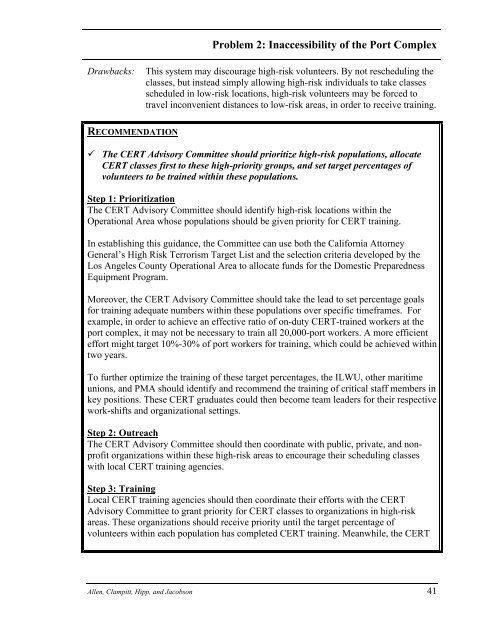Port Security Applied Policy Project - Belfer Center for Science and ...
Port Security Applied Policy Project - Belfer Center for Science and ...
Port Security Applied Policy Project - Belfer Center for Science and ...
You also want an ePaper? Increase the reach of your titles
YUMPU automatically turns print PDFs into web optimized ePapers that Google loves.
Problem 2: Inaccessibility of the <strong>Port</strong> Complex<br />
Drawbacks: This system may discourage high-risk volunteers. By not rescheduling the<br />
classes, but instead simply allowing high-risk individuals to take classes<br />
scheduled in low-risk locations, high-risk volunteers may be <strong>for</strong>ced to<br />
travel inconvenient distances to low-risk areas, in order to receive training.<br />
RECOMMENDATION<br />
¸ The CERT Advisory Committee should prioritize high-risk populations, allocate<br />
CERT classes first to these high-priority groups, <strong>and</strong> set target percentages of<br />
volunteers to be trained within these populations.<br />
Step 1: Prioritization<br />
The CERT Advisory Committee should identify high-risk locations within the<br />
Operational Area whose populations should be given priority <strong>for</strong> CERT training.<br />
In establishing this guidance, the Committee can use both the Cali<strong>for</strong>nia Attorney<br />
General’s High Risk Terrorism Target List <strong>and</strong> the selection criteria developed by the<br />
Los Angeles County Operational Area to allocate funds <strong>for</strong> the Domestic Preparedness<br />
Equipment Program.<br />
Moreover, the CERT Advisory Committee should take the lead to set percentage goals<br />
<strong>for</strong> training adequate numbers within these populations over specific timeframes. For<br />
example, in order to achieve an effective ratio of on-duty CERT-trained workers at the<br />
port complex, it may not be necessary to train all 20,000-port workers. A more efficient<br />
ef<strong>for</strong>t might target 10%-30% of port workers <strong>for</strong> training, which could be achieved within<br />
two years.<br />
To further optimize the training of these target percentages, the ILWU, other maritime<br />
unions, <strong>and</strong> PMA should identify <strong>and</strong> recommend the training of critical staff members in<br />
key positions. These CERT graduates could then become team leaders <strong>for</strong> their respective<br />
work-shifts <strong>and</strong> organizational settings.<br />
Step 2: Outreach<br />
The CERT Advisory Committee should then coordinate with public, private, <strong>and</strong> nonprofit<br />
organizations within these high-risk areas to encourage their scheduling classes<br />
with local CERT training agencies.<br />
Step 3: Training<br />
Local CERT training agencies should then coordinate their ef<strong>for</strong>ts with the CERT<br />
Advisory Committee to grant priority <strong>for</strong> CERT classes to organizations in high-risk<br />
areas. These organizations should receive priority until the target percentage of<br />
volunteers within each population has completed CERT training. Meanwhile, the CERT<br />
Allen, Clampitt, Hipp, <strong>and</strong> Jacobson 41
















